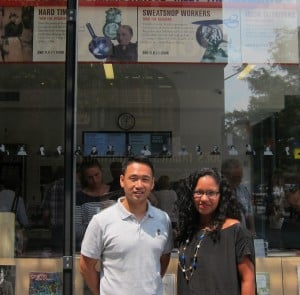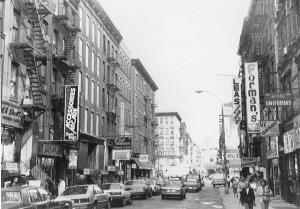Blog Archive
Collecting the Stories of Life on the LES
A lot has happened in the Lower East Side since 97 Orchard Street was closed to residents in 1935. With this in mind, we’re considering ways to extend the Tenement Museum’s narrative into the mid and late 20th century. Though we don’t yet know exactly how we’ll tell these stories, the first step is to interview some of the immigrants who worked and lived here during that time. Enter Tommy Wu and Yadira Perez –the Tenement Museum’s Oral History Project Managers. Educator Emily Gallagher is currently working with Tommy and Yadira to contact neighborhood residents and collect their stories of life on the LES. Recently, Emily took a few minutes to ask them about their work.
How did you come to be involved with our oral history project?
Tommy: I immigrated to the U.S. with my family from China when I was 8 years old, so I’m sensitive to the struggles and experiences of new immigrants. I’ve applied this to my doctoral studies at the City University of New York (CUNY) Graduate Center, specializing in globalization, state and citizenship. I’m exploring how socio-economic currents and state policies produce tensions and solidarities between peoples.
Yadira: I’m a cultural anthropologist, raised in the South Bronx by Puerto Rican parents. I’ve traveled to many different places in this world and am fascinated by how people, even in the toughest socio-political circumstances, find ways to “live.” Oral histories can give us access to how people see the world, how they navigate economic, social, political and environmental issues…that’s the stuff you can’t get by just reading history textbooks.
What are the challenges of oral history?
Tommy: For me, oral history is not just about documenting individual stories but also relating them to the larger changes happening in society. So questions about the role of the oral historian will inevitably arise. I struggle with staying true to individual stories while also providing the context for these histories. I’m careful to avoid constructing a version of history that again suppresses the voices of those that have been traditionally ignored.
Yadira: Scheduling! What’s amazing about doing oral histories is that you’re connecting and working with people—but that’s also part of the challenge. People are busy with work, families, medical visits and other responsibilities. It can be hard to find a time that works for them to just sit and talk with you. However, the back and forth is worth it if you can get them to relax, open up and speak freely.
What can oral history tell us that other primary resources can’t?
Tommy: Unlike other primary resources, oral history not only gives us access to the accounts of ideas that drive social change but may also potentially explain how these ideas came about.
Yadira: Hearing someone narrate their life story is quite revealing. Oral histories give us details about people’s daily lives, relationships and world perspectives that compliment, and complicate, official histories and discourses.
How will the work you’re doing today eventually shape tours that will be established in the future?
Tommy: Hopefully my work will bring more critical perspectives to our educational tours by incorporating the stories and sites of struggles from my interviewees. This is especially important given that the neighborhood has changed so quickly over the last few decades, and people are questioning who’s actually benefitting from these changes.
Yadira: I am focusing on capturing the stories of Latinos (specifically Puerto Ricans and Dominicans) who lived, worked and played in this barrio. These stories will give us more insight into the dynamics of these communities, the transformations of the Lower East Side after 1935, and the interactions of the Latinos with other ethnic communities.
Have you discovered anything during your oral history interviewing process that has changed your narrative or perspective on community in the Lower East Side?
Tommy: One of the emerging themes is that the Lower East Side is by no means a unified homogenous community. So when we develop a narrative for this neighborhood, we should be mindful of the cooperations, as well as the contradictions inherent in the residents’ life histories. Some of the community activists that I have interviewed contradict each other when talking about the major events that have shaped the neighborhood. They do not share the same version of history and they do not share the same vision of the future of Chinatown.
Yadira: Yes, there have been many more positive interactions between the neighborhood’s different ethnic groups (for example between Blacks and Latinos and between Latinos and Chinese) than has been traditionally understood.
— Posted by Emily Gallagher, Yadira Perez and Tommy Wu

